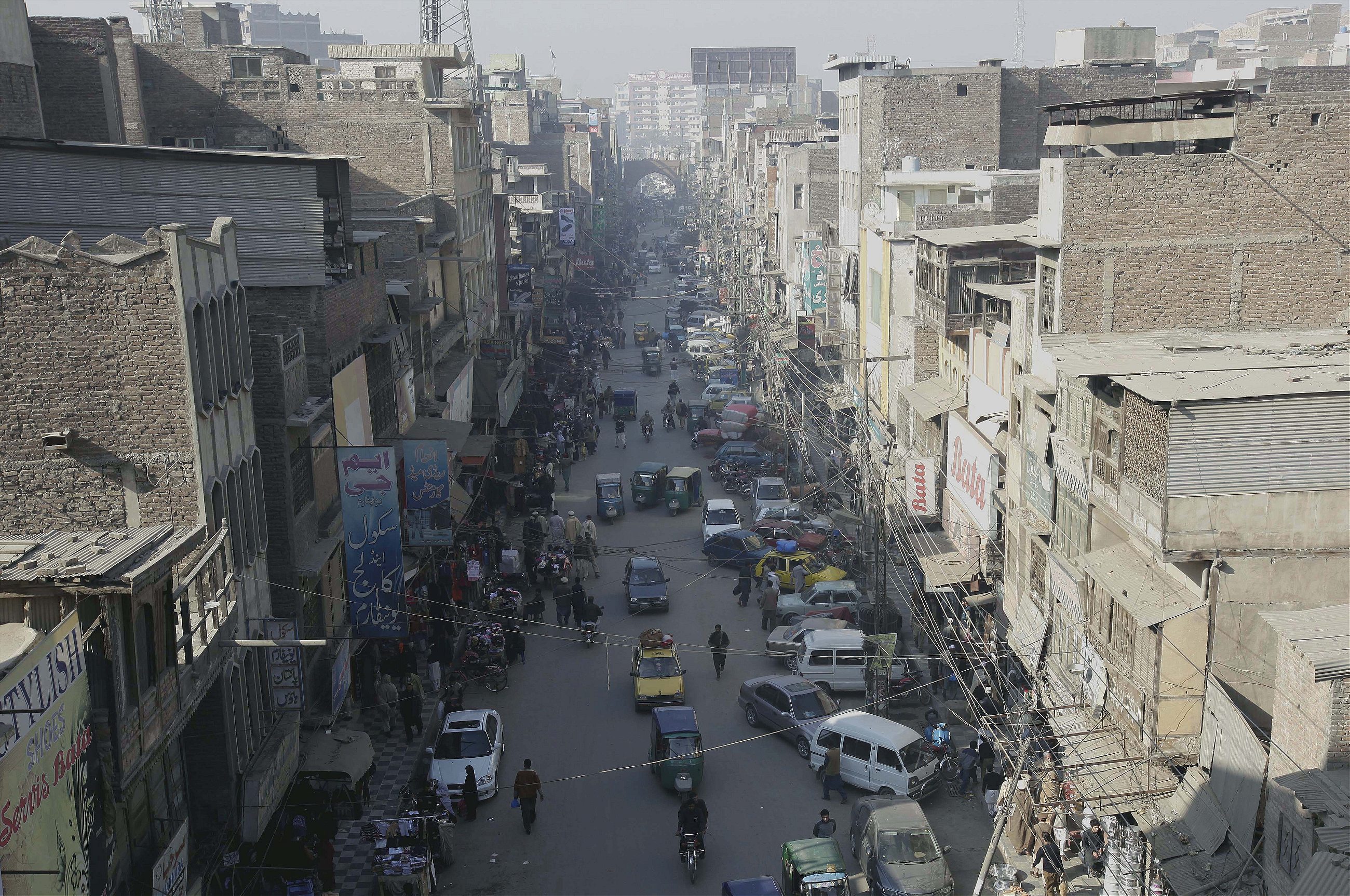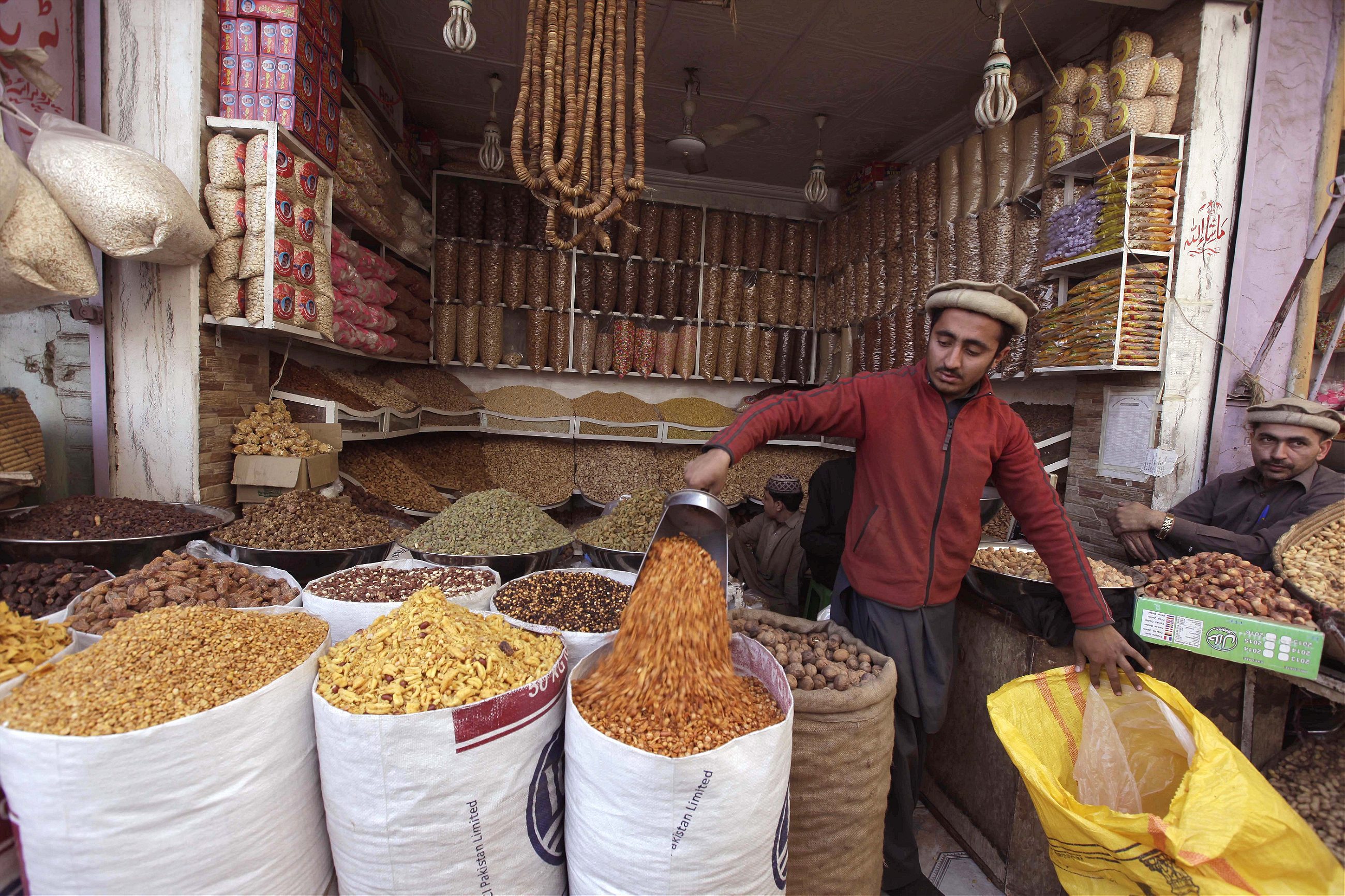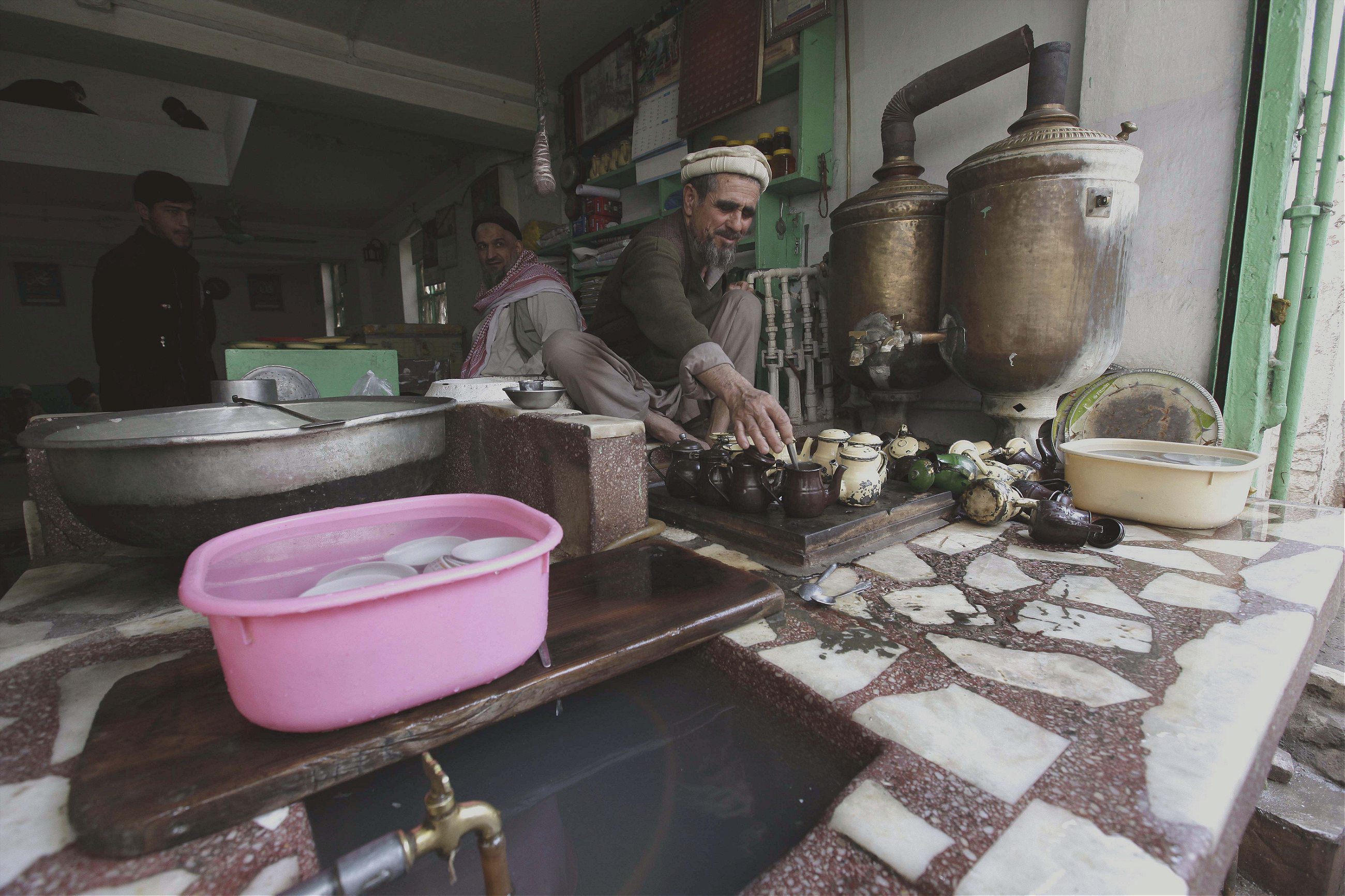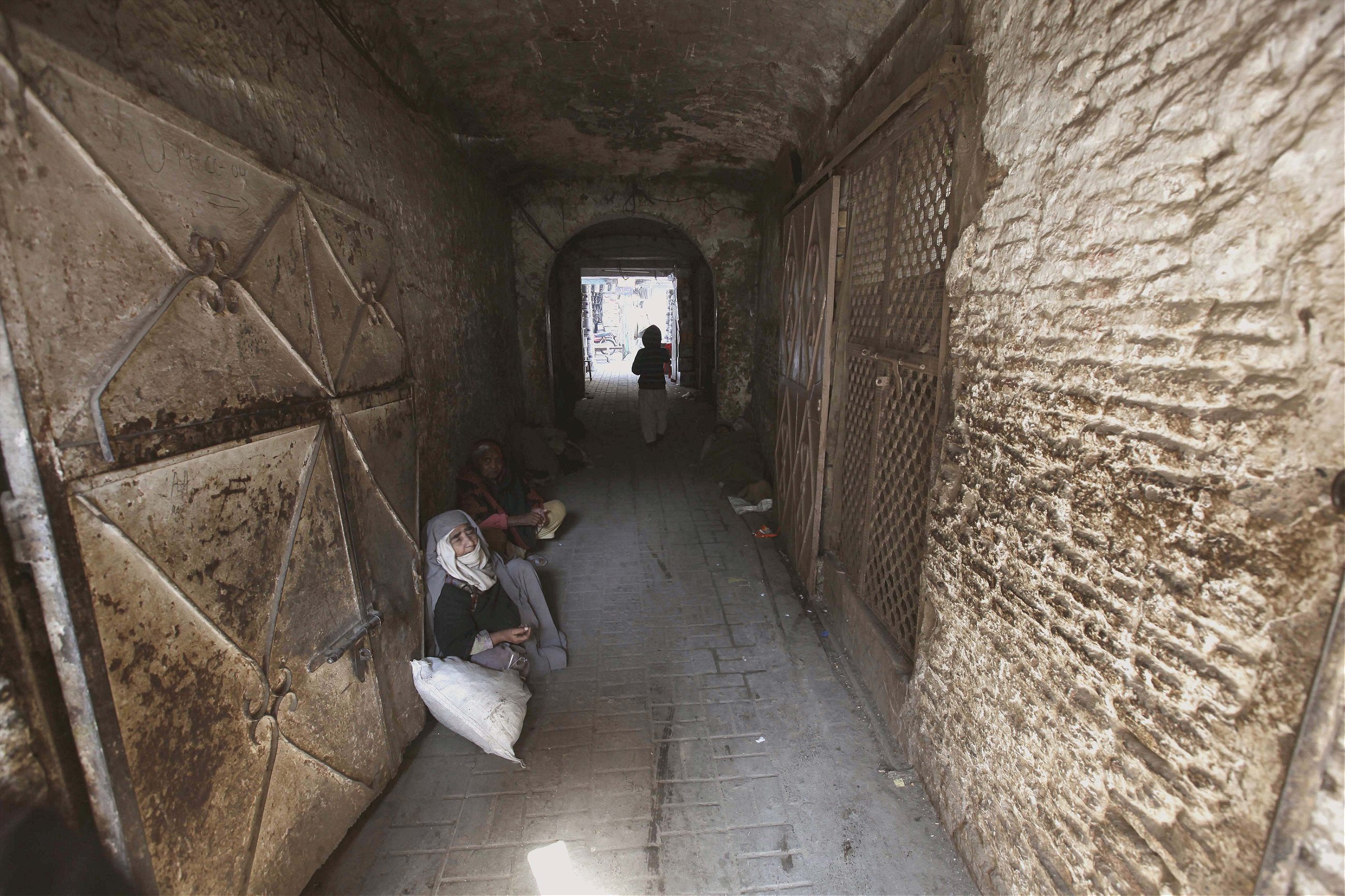Long past its glory days and plagued by spasms of violence, Peshawar’s Qissa Khwani Bazaar is at risk of being lost to history.
When spring-time flushes the desert grass,
Our kafilas wind through the Khyber Pass.
Lean are the camels but fat the frails.
Light are the purses but heavy the bales,
As the snowbound trade of the North comes down,
To the market-square of Peshawur town.
—Rudyard Kipling, The Ballad of King’s Jest
Afading and rundown tea stall overlooks Peshawar’s Qissa Khwani Bazaar—Storytellers Street. Called Zamindar Gehwa Khana, the tea stall is located near the start of the street and can be accessed through a dark stairway. Under a low ceiling, loyal customers sit on grimy charpoys—a kind of bed strung with ropes—sipping qehwa, or green tea, in small cups.
Qehwa tea stands hail from bygone days when Peshawar was an important market city in Hindustan and Central Asia. Qissa Khwani, the old walled city’s main street, is named for these very stalls, where weary travelers once converged in the evening to swap tales of love and war and arduous journeys to distant lands over endless cups of aromatic green tea, called qehwa khawni, or ‘storytelling.’ Sometimes professional storytellers held court, enthralling travelers with tall tales of adventure.
In those days, the bazaar served as a campground for trade caravans of traveling merchants from Central Asia, India, and Afghanistan, who entered the city’s gates to unload their exotic merchandise. The city’s inns hummed with steady stream of visitors from places as far away as Samarkand, Kabul, and Delhi.

For locals, the bazaar remains a place to gather, discuss news, and drink gallons of their much beloved green tea. But the market is no longer the draw it once was. The Taliban insurgency that spilled across the border from Afghanistan continues to haunt Peshawar, including the horrific December terrorist attack on a school that killed 132 school children. In recent years a series of bombings targeting the bazaar has killed scores of civilians.
Storytellers Street begins at the arched Kabuli Gate, one of 16 gates of the old walled city that once led travelers to the forbidden lands of Afghanistan and beyond. It takes just ten minutes to walk the entire length of the non-descript street, perennially crowded with people, noisy rickshaws, and cars. The east end splits into a fork: a right turn takes you into to labyrinthine alleys of the interior city; a left leads to Bazaar Misgaran, or Coppersmith Street. From Bazaar Misgaran, narrow and crowded streets leads to city’s central square, Chowk Yadgar.

An arched white marble monument has been erected in the middle of the street to honor the memory of those killed in the Qissa Khwani Bazaar massacre of April 1930, when British troops opened fire on protesters, killing hundreds. Qissa Khwani is dotted with shops on both sides that trade spices, fabrics, dried fruit, sweets, and falooda, a variety of porridge made from wheat and milk. The aroma of spices fills the air and roadside vendors dish out seekh tikka, karahai chicken, and kebab.
The green tea served here been the national beverage of Pakhtuns for centuries. Although qehwa khana is an essential element of every market and bazaar in Peshawar, it is inextricably linked with Storytellers Street. Back in the 1960s and 70s, the bazaar was the center of Peshawar’s cultural life and its tea stalls were meeting places for locals, who in the evening thronged to these outlets and sat and gossiped until late, says Ibrahim Zia, a local historian and author of several books on Peshawar. Zia says qehwa dates back to antiquity, long before British missionaries introduced black tea.

The two most popular varieties of green tea in Peshawar are regular qehwa, which is prepared by boiling tea leaves with water and sugar and adding a few crushed cardamoms for aroma, and another called sheen-do-payo, which includes milk added to regular qehwa.
Not much is known about origins of green tea here, in part because the region was for so long at the crossroads of the great movement of people and armies between India and Central Asia. Many cultural and culinary traditions followed the paths of trudging caravans and invading armies. Peshawar not only marked the end of long caravan road from Turkistan, Persia, and China, but it was also the end of Grand Trunk Road that ran across northern India. Stretching back over two millennia, Peshawar at different times fell under the sway of Muarayans, Greeks, Scythians, Kushans, Sassanid, White Huns, Hindu Shahi, Mughals, Sikhs, and the British.
A 1908 book called North West Frontier Province, published by the British Raj for administrators and officials, notes that Peshawar’s geographic location made it an important entry point for trade in Central Asia. Peshawar was a regional hub for trading raw silk, saffron, fruit, indigo, sugar, tea, gold and silver thread, lace, and Kashmiri shawls.

Fazl Rehman’s family has operated a tea stall in Qissa Khwani for two generations, down a dark cavernous alley from the main road. At the front of the shop a tea maker sits cross-legged and jostles with a large brass samovar, colorful teapots, and small china cups. Rehman receives orders from customers, who sit on plastic mats inside a small hall. Rehman grew up helping his father at this tea stall and took over the business after his father’s retirement.
Rehman says that qehwa business has fallen on hard days in Qissa Khawni—the golden days are over. There used to be eight such tea stalls in this street; now there are just two. A nearby tea stall recently closed because of rising rent, electricity, and gas prices. “As long as the city was center of trade with Afghanistan, tea stalls prospered,” he says. The decline began after the Soviet invasion in 1979, which flooded the city with refugees and hurt local businesses.
The bazaar was targeted over a dozen times in major bomb blasts
Recent decades have seen a number of bomb attacks in the bazaar. The worst came in the aftermath the U.S. invasion of Afghanistan, when Qissa Khawni and its surrounding neighborhood suffered a string of bombings of public places that killed hundreds of civilians.
The Afghan insurgency spilled into Peshawar and the bazaar was targeted over a dozen times in major bomb blasts. The mashes of barbed wire and blast walls encircling the Khan Raziq police station testify to the horrors this city has seen.
Ibrahim Zia, who owns a printing press in a nearby alley, bemoans the changing fortunes of Storytellers Street. “It used to be in very good shape in 1960 and 70s, less crowded, neat and clean,” he says. Back then there were few vehicles and most of the people used bicycles and tongas (horse drawn carriages), Zia says. The nearby Street of Coppersmiths was crowded with shoppers buying intricate brass and copper wares, which were popular dowry items. However, the advent of stainless steel was a deathblow for traditional artists. Modern hotels and multistory plazas have replaced the famed inns and caravansaries.

Zia also views the Afghan conflict as turning point in the city’s history. “All of a sudden Peshawar’s population increased by tens of thousands and it resulted in a steep increase in crime, while prices and rents also spiraled out of control,” he says.
Zamindar’s tea stall was badly damaged in an attack on September 29, 2013. Three employees were injured in the blast and the shop was forced to close for over two months.
In Rehman’s father’s day, the stalls remained open throughout the night. Back then, “the city gates closed as dusk fell and travelers had to wait for the gates to open with the call for morning prayers next day. Meanwhile, visitors thronged to tea stalls,” he says.
In these harder times, much of Rehman’s business dries up at dusk. His brother took a government job, leaving Rehman to run the qehwa khana alone. His own children have no interested in taking over the tea stand, and he will likely close it down after his ageing father dies—another small piece of Peshawar’s past lost to history.